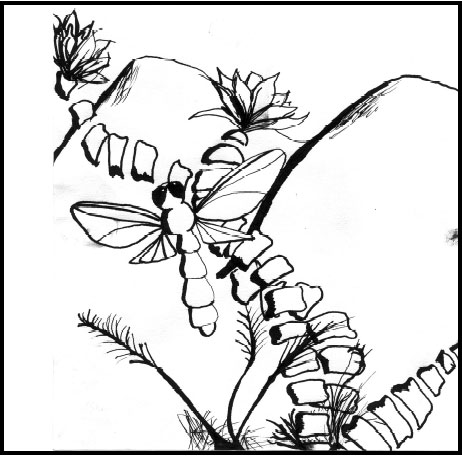

Vol. 12 No. 3
In this issue...
Reflections from the President
How the Nature Area Works with Other Groups
Garlic Mustard - Another Damaging Exotic
Nature Area Entrance - Native Garden
Upcoming Events...
November
6
Annual Meeting
10:00
AM
Centennial Farm
Members & Public
November
13
Work Day
9:00 AM
Nature Area

Garlic Mustard – Another Damaging Exotic
by Doug Thiel
Background:
 |
|
Garlic
Mustard
|
Grosse Ile has a new exotic plant that is showing up across the “Island”. It is called garlic mustard. This plant is native to Europe and was most likely introduced into the United States many years ago by settlers for food and medicinal purposes. Garlic Mustard is a cool season biennial (two season) herb that is in the mustard family. It is a stalked with triangular to heart-shaped, coarsely toothed leaves. The leaves give off an odor of garlic when crushed. First-year plants appear as a rosette of green leaves that grow close to the ground. The rosettes remain green throughout the winter and develop into mature flowering plants the following spring. The mature plants can reach up to 3.5 feet in height and produce button-like clusters of small white flowers, each with four petals in the shape of a cross. Beginning in May, seeds are produced in erect, slender pods and become shiny black when mature. By late June, when most garlic mustard plants have died, they can be recognized by the erect stalks of dry, pale brown seedpods that remain. A single plant can produce thousands of seeds.
Ecological Threat:
Garlic mustard poses a severe threat to native plants and animals on Grosse Ile. Many native wildflowers that complete their life cycles in the springtime (e.g., spring beauty, wild ginger, bloodroot, Dutchman's breeches and trilliums) occur in the same habitat as garlic mustard. Once introduced to an area, garlic mustard out competes native plants by aggressively monopolizing light, moisture, nutrients, soil and space. Wildlife species that depend on these early plants for their foliage, pollen, nectar, fruits, seeds and roots are deprived of these essential food sources when garlic mustard replaces them.
Growing Habitat:
Garlic mustard frequently occurs in moist, shaded areas such as in river floodplains, forests, roadsides, edges of woods, trail edges and forest openings. Disturbed areas are most susceptible to rapid invasion and dominance.
Current Management Practices:
Because the seeds of garlic mustard can remain viable in the soil for up to five years or more, effective management requires a long-term commitment. The goal is to prevent seed production until the stored seed is exhausted. Hand removal of plants is possible for light infestations and when desirable native species co-occur. Care must be taken to remove the plant with its entire root system because new plants can sprout from root fragments.
For larger infestations of garlic mustard, or when hand pulling is not practical, flowering stems can be cut at ground level or within inches of the ground, to prevent seed production. Once seed pods are present, but before the seeds have matured or scattered, the stalks can be clipped, bagged and removed from the site to help prevent continued buildup of seed stores. This can be done through much of the summer.
For very heavy infestations, where risk to desirable species is minimal, application of Roundup is very effective. The herbicide may be applied at any time of year, including winter (to kill over-wintering rosettes) as long as the temperature is above 50 degrees and rain is not expected for eight hours or longer.
Biological Control Agents:
Researchers are investigating potential biological control agents, which may greatly improve control of this invasive weed.
 |
| “Dragonfly”
is an original ink drawing by Audrey Travis, 11, a 6th grader at the Grosse Ile Middle School. |